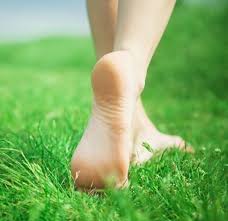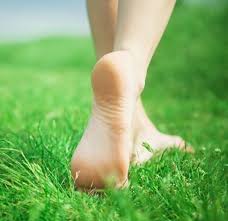Beyond Biomechanics | Addressing Foot Pain with Sensory Stimulation

I want you to picture a human foot. Now picture a person standing barefoot, and then walking barefoot. Do you see the foot striking the ground and flexing under impact, only to re-stabilize and push off just a few milliseconds later?

Often times when we think of human movement we can’t help but to be drawn to the thought of joints moving and muscles contracting. Or in the case of foot function we are quick to consider the mechanics of flat feet, high arches, pronation and supination. However when we delve deeper into the science of human movement there is more than meets the eye.
The Two Sides of Foot Function
When I teach on behalf of EBFA Global or speak to my patients I always emphasize that there are two sides to foot function (and dysfunction) – biomechanical and neuromuscular. Now both play and important role in foot function which means that both must be appreciated - however to solely treat foot pain with just one belief system in mind is inherently flawed.
In most Podiatric Medical Schools we are taught foot function and foot pathology solely  from a biomechanical perspective. This means that every patient is tested for foot mobility and told to stand statically to determine arch height and foot type. Based on this foot-focused biomechanical assessment and foot classification system the patient cause of injury and treatment protocol is determined. Some of the favorite treatment recommendations include motion-controlled footwear and custom-posted orthotic both of which are prescribed with the hopes of controlling foot-focused biomechanics and thereby reducing their foot pain.
from a biomechanical perspective. This means that every patient is tested for foot mobility and told to stand statically to determine arch height and foot type. Based on this foot-focused biomechanical assessment and foot classification system the patient cause of injury and treatment protocol is determined. Some of the favorite treatment recommendations include motion-controlled footwear and custom-posted orthotic both of which are prescribed with the hopes of controlling foot-focused biomechanics and thereby reducing their foot pain.
Beyond Biomechanics
The other side of foot function is one that is driven from a neuromuscular perspective and integrates the science of sensory stimulation and fascial systems. In the case of neuromuscular function every patient would be assessed for sensitivity of plantar mechanoceptors as well as co-activation patterns between the foot and the core. The role of minimal footwear, myofascial releasing, breathing patterns and compensation patterns more proximal would all be considered.
So which is more appropriate? Well it depends. In certain cases there will be a stronger argument towards a more biomechanical influence and in others it is more sensory. This means it really is a marriage between the two approaches that provides the greatest patient outcome.
Sensory Stimulation in Foot Pain
My practice and Podiatry career is built around bringing an awareness to the important role sensory stimulation has on foot function and foot pain.
With every step we take impact forces are entering the foot as vibration. This vibrational noise stimulates unique mechanoceptors on the bottom of the foot and is used to coordinate the loading of impact forces through coordinated contractions of the intrinsic (small) muscles of the bottom of the foot. This co-contraction leads to a stiffening or strengthening response of the foot.
Researchers such as Nigg et al. and Robbins et al. have demonstrated a direct relationship between sensory stimulation of the plantar foot and intrinsic muscle strength concluding that one is necessary for the other. This means that if our footwear or orthotics disconnect us from sensory stimulation – as in the case of cushioned footwear – this can actually weaken our foot making us susceptible to plantar fasciitis, Achilles tendinitis and stress fractures.
Beyond Vibration Stimulation
 Vibration stimulation is an extremely important sensory stimulation that enters our foot however it isn’t the only stimulation. Another important stimulation is the ability for our foot to determine texture and if a surface is rough or smooth. This information is used to help maintain dynamic balance (think walking on ice).
Vibration stimulation is an extremely important sensory stimulation that enters our foot however it isn’t the only stimulation. Another important stimulation is the ability for our foot to determine texture and if a surface is rough or smooth. This information is used to help maintain dynamic balance (think walking on ice).
Enter the merkel disk mechanoceptors. These superficial sensory nerves are used to determine what’s called 2 point discrimination which is translated to roughness or the texture of a surface. Surface texture and insole texture is one of the most studied aspects of foot stimulation and posture or gait. From decreased medial lateral sway in patients with Parkinson’s or MS to reduced prefrontal cortical activity in atheltes post-concusion the applications are promising!
One area that hasn’t been focused on for sensory stimulation and foot function is foot pain. I am here to change the awareness around this concept and share the powerful application of sensory stimulation and foot pain.
As we mentioned earlier sensory stimulation of the foot leads to a contraction of the intrinsic muscles of the foot. Intrinsic muscle contraction is not only is a criticial step in the damping of impact forces but has also been shown to increase the medial arch and build co-activation contractions in the core.
The Evolution of Textured Insoles
In October 2017 Naboso Technology launched the first-ever commercially available  textured insole! Naboso Technology essentially brought the science of touch and years of textured insole research to the market place giving new hope to people with foot pain.
textured insole! Naboso Technology essentially brought the science of touch and years of textured insole research to the market place giving new hope to people with foot pain.
Available in two strengths - Naboso 1.0 (1mm texture) and Naboso 1.5 (1.5mm texture) Naboso Insoles are designed to be worn without socks (or at the most very thin socks). They fit into all footwear, are freely movable in all planes of motion and are only 3mm thick.